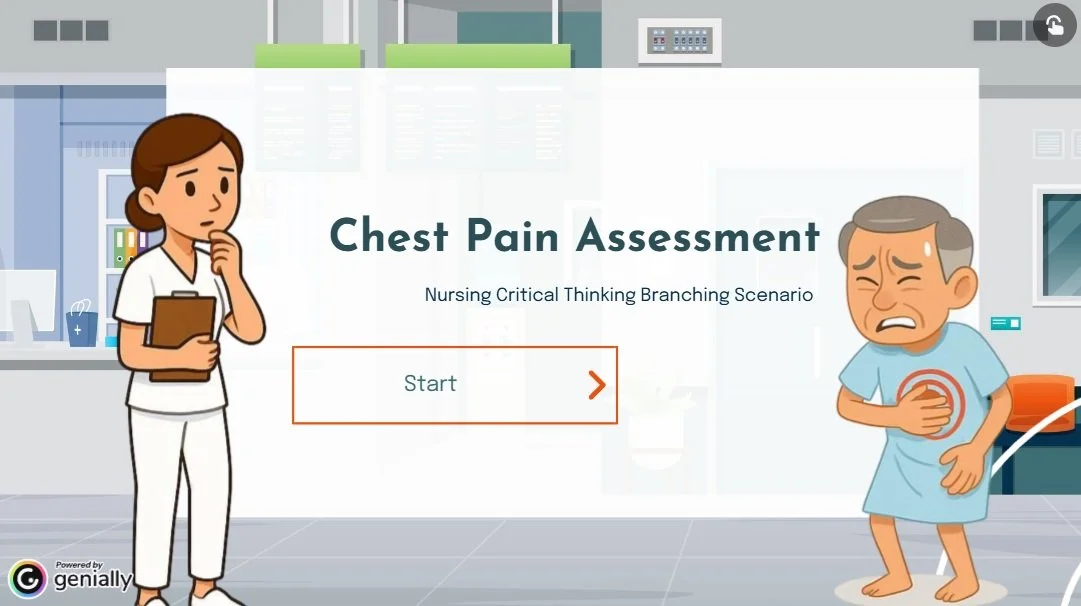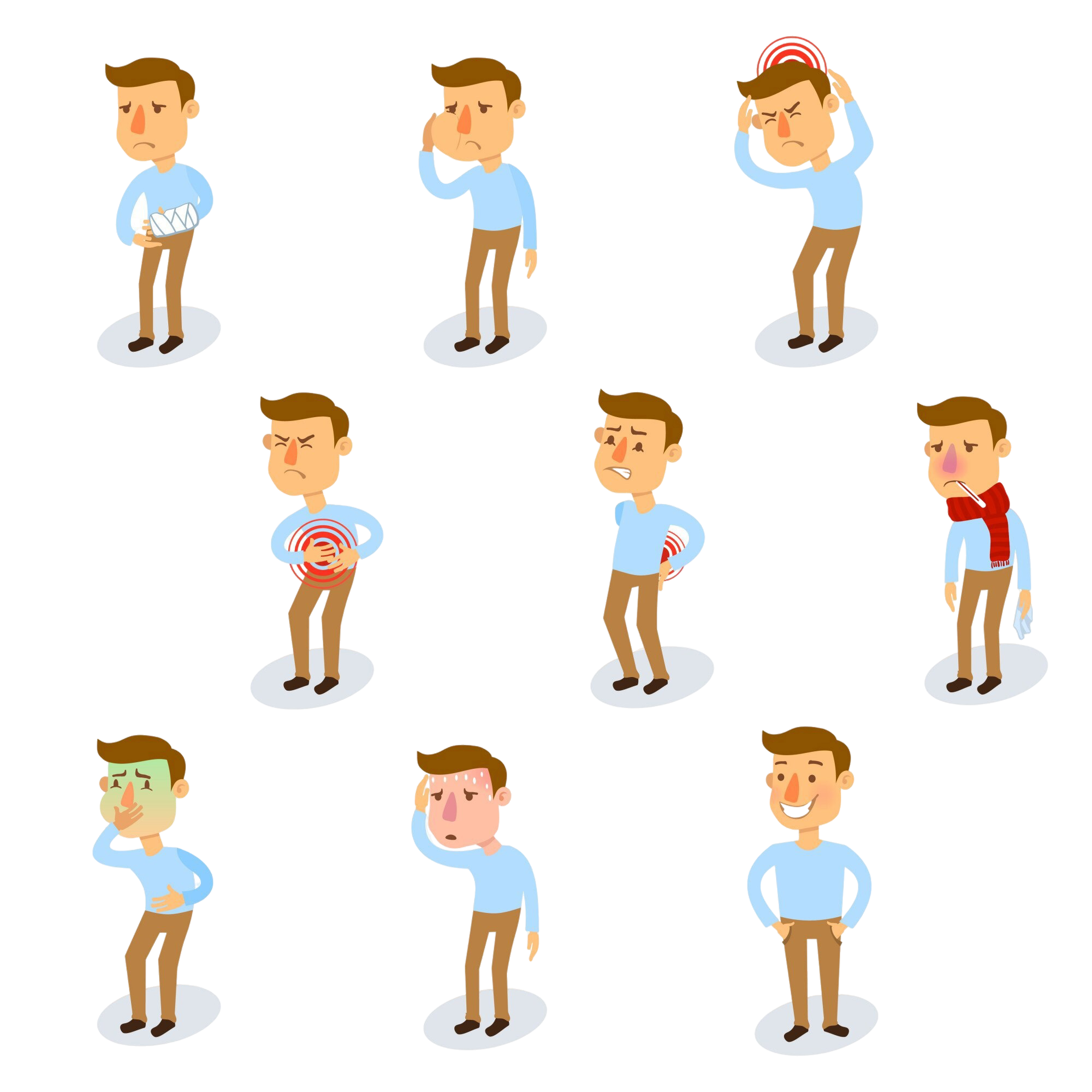
Chest Pain Branching Scenario
Why I created it
I aimed to build a realistic branching scenario that tests critical decision-making under time constraints. For nurses, quick thinking can save lives.
I focused on keeping a consistent look and feel. I wanted the training to look professional while still being medically accurate. This meant careful design choices throughout the project.
I wanted to improve my image creation skills. I used AI tools like DALL-E along with standard design resources. This helped me create good visuals without needing expensive equipment or special skills.

Project Overview
This project creates an interactive simulation for nursing education that teaches chest pain assessment and management. It uses branching scenarios where learners make decisions and see consequences.
The simulation targets nursing students and new graduate nurses who need more clinical experience. It helps them develop critical thinking skills when working under time pressure.
This skill is vital when treating acute coronary syndrome (ACS). For STEMI patients (a type of heart attack), every 30-minute delay in treatment increases death risk by 7.5%.
The simulation provides safe practice for these high-stakes situations before nurses face them with real patients.
Learning Objectives
The simulation addresses five measurable learning objectives that build essential clinical competencies:
Apply critical thinking during initial assessment of chest pain patients
Demonstrate proper nursing prioritization in potential cardiac emergencies
Interpret basic ECG findings indicative of a STEMI
Communicate effectively with patients experiencing acute symptoms
Recognize the importance of rapid response in time-sensitive cardiac conditions
All content adheres to current American Heart Association guidelines.
Demo
Design process
Instructional Strategy
The core instructional approach centers on a realistic branching scenario following one patient through complete chest pain assessment. The scenario incorporates critical decision points with meaningful consequences that affect patient outcomes. Immediate feedback is provided based on the choices made, with progressive vital sign changes reflecting the interventions selected.
Storyboarding and Visual Design Process
I created a detailed flowchart showing how the scenario branches at three main decision points:
Assessment (examining the patient)
Diagnostic testing (ordering and interpreting tests)
Intervention (treating the patient)
I used Figma (a design software) to create wireframes and a style guide. This helped keep the visual design consistent throughout the entire training experience.
In Figma, I created three pages: 1) for brainstorming and inspiration, 2) for the styles guide and curating consistent visual assets, 3) low-fidelity wireframe that includes the basic interface of the design.
Figma allows me to “sketch” but in an Instructional Design kind of way. By adding Figma to my design toolkit, I’m integrating my illustrator background into my Instructional Design.
Tools and Technologies
Figma for planning and wireframing
Freepik for image asset curation
DALL-E for consistent character image creation
Genially for final integration and interactive elements
Interactive elements
Several interactive elements enhance the learning experience:
A pop up interactivity of a patient chart that highlights changes in vital signs based on interventions
A pulsing red button that expands to reveal patient symptoms when clicked, simulating the process of symptom checking
Decision points with multiple-choice options that branch the scenario in different directions
These elements were designed with accessibility in mind, incorporating plain language, text alternatives for all clinical visualizations, and consistent navigation controls.
Reflections
One challenge was creating realistic patient representations without making them. I was working on a time constraint and my original concept involved Vyond animations. For a branching scenario this would have turned into a much larger project that would require much more time. I discovered that DALL-E completely resolved this challenge. Here’s the process that streamlined development for this project:
I made a style guide in Figma to keep everything consistent
I found character sets on Freepik that matched what I wanted
I prompted DALL-E to create consistent character images
I removed image backgrounds using Freepik's AI tools
This was a major breakthrough for me. I saved lots of time by giving DALL-E the right instructions to create the images I needed. What could’ve been days of asset creation became less than an hour process.
From this project, I also realized that Genially works as an authoring tool in much the same way that Canva serves as a more user-friendly alternative to complex programs like Photoshop or Illustrator. Both make sophisticated creative tasks more accessible to everyday users. Genially served all of my needs. It’s interactivity options gave me the freedom to create immersive and engaging content without having to experiment with complicated mechanics. It honestly functions like Canva and I had no problems getting used to the software. Moving forward, I’ll definitely use Genially for future projects, especially for microlearnings or for projects that need quick turnaround times.
Reference picture and style
DALL-E generation
DALL-E generation
DALL-E generation
Future Improvements
For future versions, I plan to make these improvements:
Adding professional-quality videos to make the experience feel more real
Building it in Articulate Storyline so I can create more complex interactive elements
Making users interpret ECG readings themselves instead of just giving them the answers
Creating more branching paths, especially for wrong choices, to help users learn more
Including more advanced treatment options for users to practice higher-level decision-making
Competencies
Evidence-based clinical education design that adheres to established medical guidelines
Strategic AI utilization for image curation and creation
Rapid prototyping and development techniques
Effective branching scenario design using concept mapping and storyboarding methodologies












